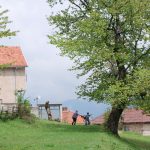During 2024 and 2025, five research projects are planned to be implemented as part of the Young Ecologists Support Program “Dr. Ljupcho Melovski”. Below are the brief summaries of the research projects.
MORPHOLOGICAL AND GENOMIC DIVERSITY OF E. GLAREOSA AGG. IN MACEDONIA AND SOME REGIONS OF THE BALKAN PENINSULA
Leader: Angela Ivanova
In recent years, the species Euphorbia glareosa Pall. ex. Bieb. and related taxa have been the subject of research in Macedonia due to their polymorphism and problematic taxonomy. This species, listed in the Flora of Macedonia (Micevski (1998)), is referred to as Euphorbia nicaeensis All. var. trichocarpa Neilr. The aim of the project is to contribute to resolving the taxonomic status of the taxa from E. glareosa agg. through karyological and morphometric analyses of populations of this species in Macedonia and the region. Additionally, data on the distribution and habitat requirements of these taxa will be provided. The obtained data, besides assisting in resolving the taxonomic status of the taxa, should provide new information on the floristic diversity of Macedonia, as well as information with conservation significance for the ecological valorization of a certain area.
MAC-ECO-PHYTO Conservation of ecosystems – the role of the national collection of phytopathogenic microorganisms: important data for conceptual ecological solutions for plant diseases
Leader: Jansel Bukovets
Phytopathogenic microorganisms are a current topic of discussion, especially in periods when organic production is increasingly encouraged and various microbiological fertilizers are being produced in large quantities instead of toxic pesticides. In our country, there are few institutions focused on this issue. Some of them are more focused on commercializing existing microbiological preparations, while only a few are engaged in the science and research of these specialized life forms. The aim of the project is the isolation, characterization, and identification of phytopathogenic bacteria and fungi attacking plants. The obtained isolates will be selected and stored in a national collection. This national collection will serve in the research of biodiversity in order to stimulate and obtain a better picture of all harmful plant diseases and their causative agents. Additionally, the national collection will provide permanent storage of cultures and availability for various tests and experiments in in vitro and in vivo conditions.
MILK THISTLE (SILYBUM MARIANUM (L.) GAERTH) – Weed or useful medicinal plant with potential for phytoremediation of soils
Leader: Jovana Gjorgievska
Milk thistle, Silybum marianum (L.) Gaerth., Asteraceae, is a biennial nitrophilic weed plant that grows autochthonously in the Mediterranean region on degraded soils, and due to its medical significance and demand, it is cultivated. The flavanolignan complex-silymarin comprises several bioactive phytocomponents with strong hepatoprotective and antioxidative effects, mainly concentrated in the fruits.
The need for the remediation of polluted soils through phytoremediation has become particularly significant in recent decades. The presence of metals in the soil enables plants to accumulate metal-phytoremediation, but it can also improve the production of secondary metabolites. It is known that different parts of plants collected from different geological regions possess different contents of phytocomponents (Papadimou et al., 2024).
The research in this project aims to establish the connection between the content of bioactive flavonolignan components in fruits and herbs and the ability of this plant to absorb heavy metals from the soil, thus assessing the potential of milk thistle for phytoremediation of polluted soils.
Study of the distribution and diversity of bioactive compounds in endemic plant species from the Prilep-Mariovo region
Leader: Mr. Marinela Cvetanoska
The territory of North Macedonia is one of the richest in Europe in terms of the diversity of endemic plant species. Many of them, although taxonomically proven, have not been sufficiently researched regarding their chemical composition and biological activity. By characterizing bioactive compounds, their belonging to a certain species can be confirmed, but also their medical significance can be emphasized.
The main goal of this research is to analyze the chemical profile of lowland endemics, mainly located in the vicinity of Prilep and Mariovo, in order to establish a correlation between taxonomic characteristics, geographical location, nature, and content of bioactive compounds.
The project is planned to be implemented in 5 phases, with a greater focus on the second and third phases. The results of the research will contribute to a better understanding of the application of these endemics and an assessment of the resources and economic potential of our country.
B-Yeast – biodiversity of yeasts in different cereal species: understanding the ecology and function of yeasts in microbial ecosystems
Leader: Nikola Radmanovic
Microbial communities of the phyllosphere are rich habitats with numerous microorganisms that, through complex interactions, affect the growth and development of their plant hosts. Within these ecological communities, present members represent yeasts (Gouka et al. 2022). Their roles are diverse; however, their metabolic adaptability does not mean that these communities do not feel the destructive effects of harmful herbicides, pesticides, and insecticides (Ando et al. 2005; Giehl et al. 2023). Additionally, global trends in studying these communities are already underway, mostly with the aim of finding similar yeasts for industrial purposes. The goal of this proposal-project is to gain insight into the biodiversity of yeasts naturally inhabiting cereal crops and to show quantitative and qualitative differences between these communities. This palette of natural yeasts with diverse eco-metabolic functions can find future use as biofungicides or biopesticides or be found as an alternative to commercial industrial strains for greener and sustainable industrial and agricultural practices (Hernandez-Fernandez et al. 2021).



